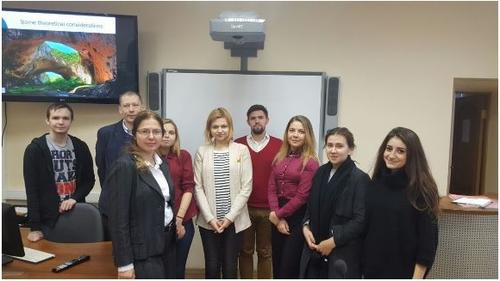Junior Research Stay in St. Petersburg
Climate Change Vulnerabilities and Adaptations in Russia
News from Jan 20, 2017
Report by Tina Schivatcheva
The boreal forests, adapted for life in harsh environmental conditions, are a living treasure and a very important carbon storage. Russia is home to about 60% of all boreal forests in the world, which represents 25% of the global forest standing volume. Almost 95% of the Russian forest area consists of boreal forests or the taiga, as they are called in Russia. The major tree species that make up these forests are larch, pine, Siberian pine, spruce. Within the coniferous group, the larch dominates the forest stands of Siberia and the Far East (encompassing more than half of the total area of the conifers). Pine trees occupy 23% and spruce trees 15% of that area. More than of all forests in the Russian Federation are growing on the permafrost soils of Siberia and the half Far East. Thus, a major part of the Russian forests is characterized by low growth potential and high vulnerability to disturbances.
In spite of the harsh conditions, these northern lands have traditionally been inhabited by indigenous peoples, who have successfully adapted centuries-old traditions to the modern economy by practicing commercial reindeer herding. The traditional way of life of the people of the North is closely based on the use of all forest resources and also includes hunting, fishing, gathering of berries and mushrooms, etc.
Having extensive forest management experience, Russia is recognized to be one of the world’s leader in silviculture, forest protection, science and research, yet today Russia faces formidable environmental challenges. One of the most pressing concerns of the Russian scientific community is climate change and its impact on the Arctic. Even now in some areas of Siberia, the temperatures are already an astounding 20 degrees Celsius higher than the ‘normal’ averages – i.e. instead of -25 degrees, they are -5 degrees Celsius. This very sudden change is already having huge impact on the fragile northern ecosystems. As the permafrost melts, a phenomenon, characterized as ‘methane holes’ occurs and cities and infrastructure, built on the permafrost are in danger of sinking and being destroyed. The permafrost melting also represents a considerable ecological threat, as almost 80% of the forests located in the Asian part of Russia grow on permafrost soils.
The warmer climate also encourages the unprecedented spread of diseases. A recent anthrax epidemics has had a devastating impact on the domesticated reindeer and also on the native people of the north. As the reindeer herds had to be terminated, herders had to abandon their traditional lifestyles. Even though the indigenous people received government support, the sudden loss of their hereditary occupation deeply and negatively impacted the social and individual health of these people.
Russia earnestly seeks solutions, trying to address these urgent problems and at the latest Marrakech Climate Change Conference (November 2016), the official Russian delegation was accompanied by a delegation of Russia’s Indigenous Peoples. A promising adaptation strategy is community adaptation to reduce disaster risk and build resiliency against climate change. However, these local efforts ought to be complemented by a supportive international framework and such is still lacking. Still too few people are aware of the ecological transformations taking place in the taiga. ‘Huge changes are happening, but they take place in the remote northern areas, so still very few people are being aware of the magnitude of the already existing climate change impact’, caution the Russian scientists.
The pressing environmental problems underscore the necessity to make additional efforts in educating competent and capable professionals. My research exchange stay at SPbGU allowed me to learn by experience about the innovative teaching methodologies of this venerable institution. Prof. Nikolay Bobylev also kindly invited me to deliver four lectures to students at both the graduate and undergraduate levels; they also studied several different disciplines, such as environmental governance, political geography, and natural resources management.
The students received me very kindly and warmly. I was pleasantly surprised by how eager to learn and how inquisitive they were. Prof. Bobylev guided me in selecting educational materials, which would best fit with the general thematic orientation of his lectures and with my research topic of ‘Sustainable environmental governance at the urban-environment interface’. Since it is impossible to understand the nature of environmental governance in Europe, without knowledge of the environmental governance institutions of the European Union, I had to prepare separate background lecture material on the topic of EU's institutional architecture for sustainable environmental governance as well as on the types of dynamic interaction of the EU institutions. In the preparation of the educational materials I have been guided by Prof. Miranda Schreurs' analytical contributions, as well as by the contribution of other scholars from the Freie Universität of Berlin, thus introducing the new and interesting environmental governance ideas of the German academia to the Russian students.

